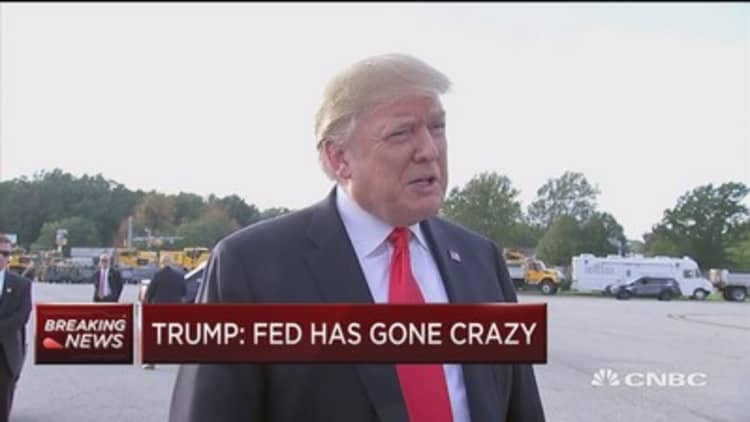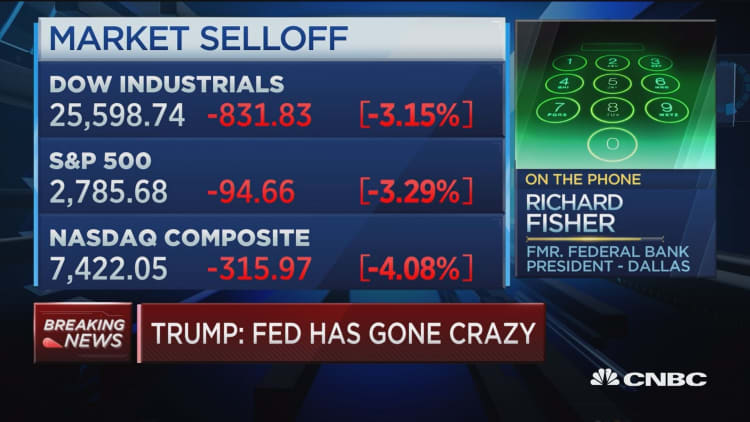The recent financial market volatility has been caused at least in part by the Federal Reserve, and central bank officials may not mind.
In fact, if there's one overriding message that can be taken from Fed officials' recent public comments, it's that they see their days of holding the market's hand as over.
The highly interventionist Fed from the financial crisis era is making room for one that harks back to at least a generation ago, before zero interest rates, quantitative easing and the assurance that each Fed chairman had a "put" below where the stock market could not fall before action happened.
For Wall Street, the consequences have been a remarkable rise in interest rates and a volatile stock market that saw a blowout loss that reached more than 800 Dow points Wednesday.
That's the way it is likely to stay for a while.

"The Fed is looking to undo the perception that they are the ones that are driving economic growth," said Michael Yoshikami, CEO and founder of Destination Wealth Management. "They're going to not only raise interest rates, but they're also going to begin to unwind what they think is an overdependence by the market on Fed policy as the one key indicator for where the economy is headed."
Indeed, Fed monetary policy and market movements have been interlocked for the past decade. The central bank took its benchmark rate to near zero during the financial crisis and instituted three rounds of balance sheet expansion by buying some $3.7 trillion worth of Treasurys and mortgage-backed securities.
More than that, former central bank chairs, including Ben Bernanke and Janet Yellen, were perceived to be ready to act swiftly at any cracks in the market or economic data.
Chairman Jerome Powell, though, appears ready to put a new stamp on the Fed as a backstop but not as a nursemaid — a "supporting actor," as Chicago Fed President Charles Evans said a week ago.
"It's really a pendulum swing," Yoshikami said. "People are going to be scratching their heads, but they're not really thinking back to the way the Fed used to operate. The Fed has not always been so interventionist."
'There is no Powell put'
To be sure, the market's most recent upset also has been tied to a particularly strong run of economic reports. But that, too, is tied into the Fed, as the outperformance has led to a belief that inflation is heating up and the Fed will keep raising rates.
That realization was compounded when much of Wall Street drew the wrong conclusion from the Fed's most recent meeting. Officials voted to remove the word "accommodative" from the post-meeting statement to describe policy, and many market participants took that to mean that the Fed had done most of its work normalizing interest rates and soon would stop.
Since the meeting, several Fed officials and Powell in particular have sent the message that the Fed intends to keep raising rates — gradually — so long as economic conditions dictate that it's appropriate.
That includes through periods of market discontent and even as President Donald Trump continues to criticize the central bank for the rate hikes.
"There is no Powell put," said Joseph Brusuelas, chief economist at RSM. "They are absolutely moving in the direction of normalization of monetary policy and withdrawal of what is essentially the stance of the Bernanke/Yellen Fed."
Doing so won't be easy, though. After all, the Fed went where no central bank has gone before, and undoing all that easing won't be easy. In addition to raising rates, the bank is reducing its balance sheet by allowing up to $50 billion a month in bond proceeds to roll off while reinvesting the rest.

"How do you exit that? That's a tricky phenomenon, and one I'm not sure these central banks are able to do as seamlessly as they want," said Joe LaVorgna, chief economist for the Americas at Natixis. "They shouldn't talk too tough. The market is going through a tantrum."
There are also no guarantees on how long the economic boom will last.
As things stand, the Fed plans on hiking once more this year and is indicating three more in 2019 and one more in 2020. However, Powell has been clear that the forecast is always open for revision, even though he subscribes to the current plans.
"We think that the cumulative effects of the Fed's rate hikes, in particular the surge in market rates, are going to start taking an increasing toll on rate-sensitive sectors of the economy," said Andrew Hunter, U.S. economist at Capital Economics. "If we're right and the economy continues to slow, there's a fairly good chance that by early 2020, they would definitely start to think about if not actually go ahead with rate cuts."
For now, though, the path seems to be away from knee-jerk market reactions.
And with so much strength in the economy, Yoshikami said, the market eventually will accept the Fed's new role.
"It's going to initially be startling to some folks that the Federal Reserve could take their hands off the wheel," the Destination Wealth founder said. "But I think given what we know today, there's enough other positives in the economy that the Federal Reserve can do this and the market can adjust."


